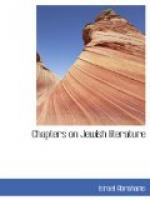The geographical literature of the Jews did not lose its association with Messianic hopes. Antonio de Montesinos, in 1642, imagined that he had discovered in South America the descendants of the Ten Tribes. He had been led abroad by business considerations and love of travel, and in Brazil came across a mestizo Indian, from whose statements he conceived the firm belief that the Ten Tribes resided and thrived in Brazil. Two years later he visited Amsterdam, and, his imagination aflame with the hopes which had not been stifled by several years’ endurance of the prisons and tortures of the Inquisition, persuaded Manasseh ben Israel to accept his statements. On his death-bed in Brazil, Montesinos reiterated his assertions, and Manasseh ben Israel not only founded thereon his noted book, “The Hope of Israel,” but under the inspiration of similar ideas felt impelled to visit London, and win from Cromwell the right of the Jews to resettle in England.
Jewish geographical literature grew apace in the eighteenth century. A famous book, the “Work of Tobiah,” was written at the beginning of this period by Tobiah Cohen, who was born at Metz in 1652, and died in Jerusalem in 1729. It is a medley of science and fiction, an encyclopedia dealing with all branches of knowledge. He had studied at the Universities of Frankfort and Padua, had enjoyed the patronage of the Elector of Brandenburg, and his medical knowledge won him many distinguished patients in Constantinople. Thus his work contains many medical chapters of real value, and he gives one of the earliest accounts of recently discovered drugs and medicinal plants. Among other curiosities he maintained that he had discovered the Pygmies.
From this absorbing but confusing book our survey must turn finally to N.H. Wessely, who in 1782 for the first time maintained the importance of the study of geography in Jewish school education. The works of the past, with their consoling legends and hopes, continued to hold a place in the heart of Jewish readers. But from Wessely’s time onwards a long series of Jewish explorers and travellers have joined the ranks of those who have opened up for modern times a real knowledge of the globe.
BIBLIOGRAPHY
Steinschneider.—Jewish Literature, p. 80.
A. Neubauer.—Series of Articles entitled
Where are the Ten Tribes,
J.Q.R., Vol. I.
BENJAMIN OF TUDELA.
A. Asher.—The Itinerary of Benjamin
of Tudela (with English
translation and appendix by Zunz.
London, 1840-1).
PETACHIAH OF RATISBON.
A. Benisch.—Travels of Petachia of Ratisbon
(with English
translation. London, 1856).
ABRAHAM FARISSOL.
Graetz.—IV, p. 413 [440].
DAVID REUBENI.
Graetz.—IV, p. 491 [523].
H. WESSELY.
Graetz.—V, p. 366 [388].




